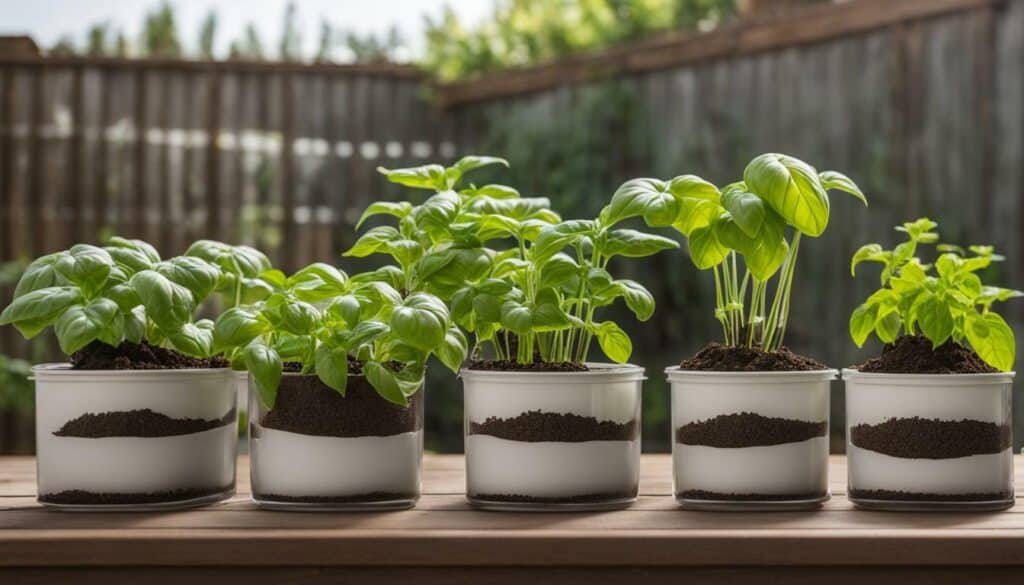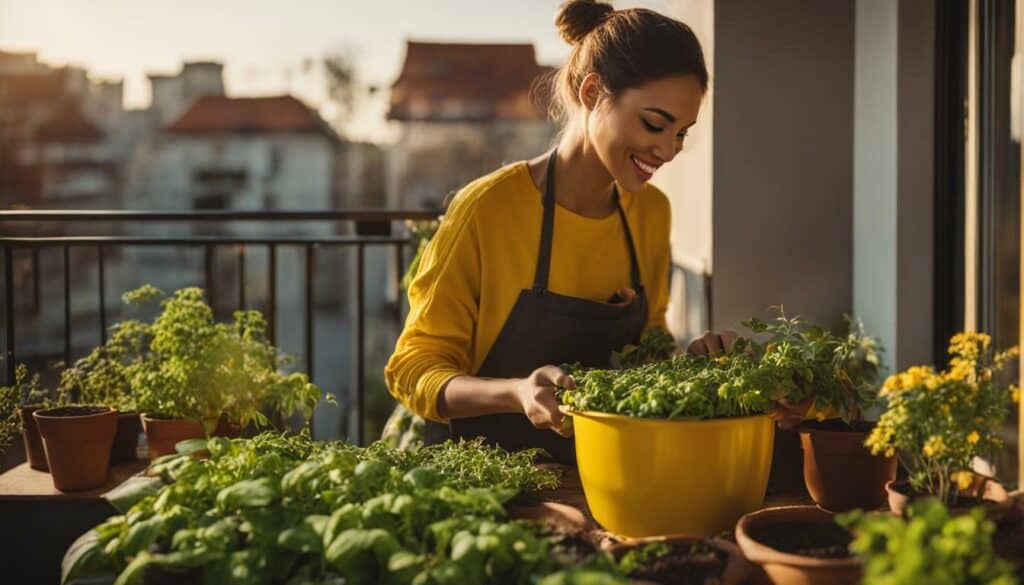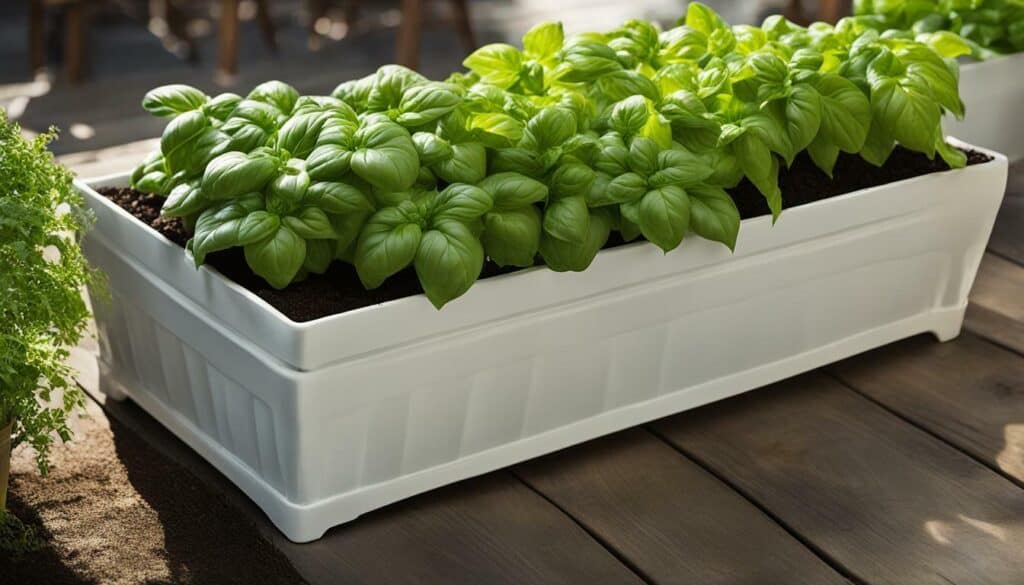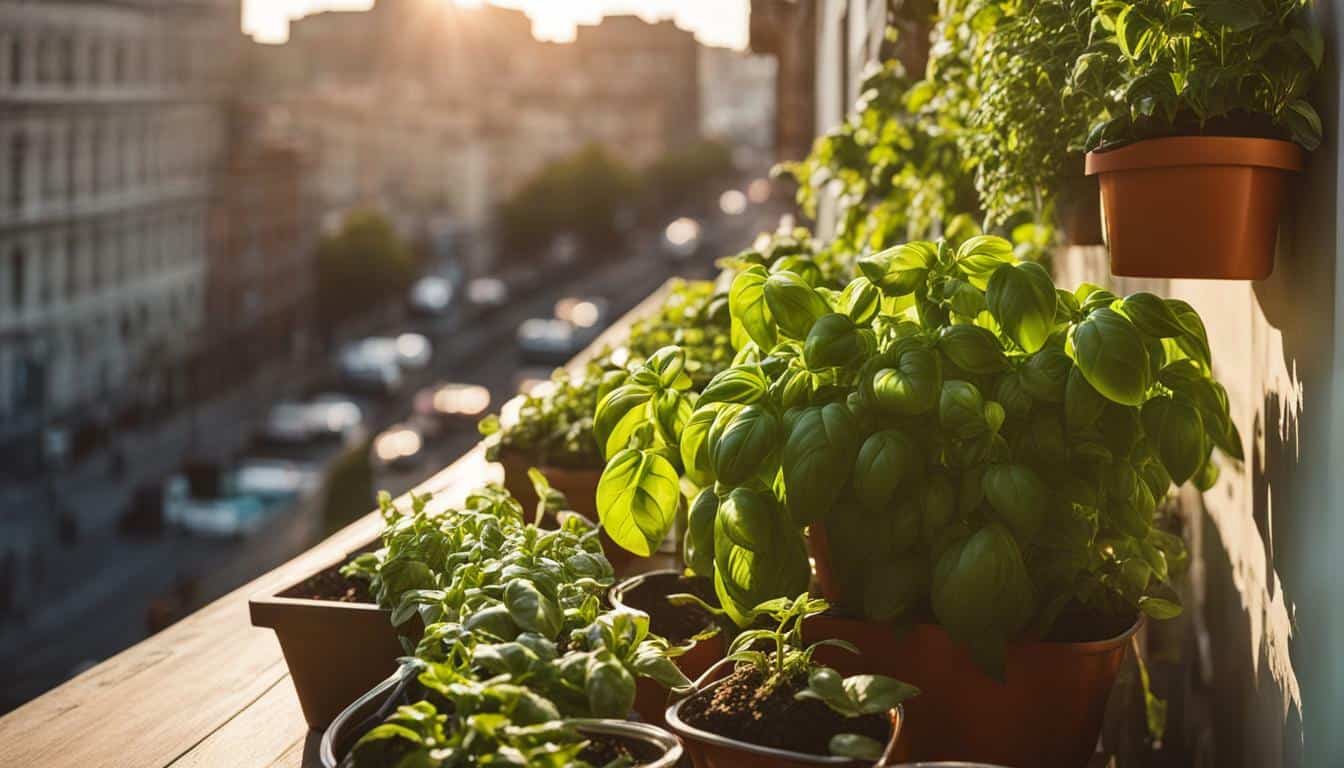Growing basil in containers is a great way to have fresh basil at home. Whether you have limited space or want to grow herbs indoors, container gardening makes it possible to successfully grow basil in pots. There are several basil varieties that can be grown in containers, and it’s important to choose the right pot and soil for optimal growth.
When selecting a pot for growing basil, it’s best to choose a container that is at least 6 to 8 inches wide. Terracotta clay pots and fabric grow bags are both excellent choices for growing basil. Basil plants require rich, well-drained soil with a pH between 6.0 and 7.5. Adding compost to the potting mix before planting can help improve soil quality.
Basil seeds can be started indoors about 6 to 8 weeks before the last frost date, and seedlings can be transplanted outdoors after the danger of frost has passed. Proper care and maintenance of basil plants in containers include regular watering, pruning, and fertilizing. Basil can also be grown indoors with the right conditions, such as adequate sunlight or grow lights and proper watering, pruning, and pest control measures.
Key Takeaways:
- Basil can be grown in containers for a fresh supply of flavorful herbs at home.
- Choose a pot that is at least 6 to 8 inches wide and provide rich, well-drained soil with a pH between 6.0 and 7.5.
- Basil can be started from seeds or propagated from young plants or cuttings.
- Proper care and maintenance include regular watering, pruning, and fertilizing, and pest control measures.
Choosing the Right Container and Soil for Basil Plants
Basil plants need a pot that is at least 6 to 8 inches wide with good drainage. However, larger containers are preferred, as they provide more room for root growth. Terracotta clay pots and fabric grow bags are excellent options for growing basil, as they allow for proper drainage and aeration of the soil.
The soil used for growing basil should be rich, well-drained, and have a pH level between 6.0 and 7.5. Adding compost to the potting mix before planting can enhance the growth of basil. It is crucial to select the right soil for basil plants, as they require proper nutrition and moisture retention for optimal growth.
When selecting a container, it is important to consider the type of basil being grown and the container’s size and material. Different types of basil have different growth habits and root systems, which may require specific container sizes and shapes. For example, Thai basil may require a deeper container than other types of basil due to its longer roots. Additionally, containers made of porous materials like terracotta clay help regulate soil moisture levels and prevent overwatering, while fabric grow bags provide excellent drainage and aeration for the roots.

It is also important to note that basil can be grown from seeds or purchased as young plants. Starting basil seeds indoors about 6 to 8 weeks before the last frost date is recommended. Planting basil seeds about ¼ inch deep and spacing them apart will ensure successful germination. Once the basil seedlings are a few inches tall and have true leaves, thinning them out and leaving only the strongest plants behind is essential.
When planting basil in a pot, it is important to dig a small hole in the potting mix at the same planting depth as it was growing in its original pot. Feeding and fertilizing basil is not necessary if the potting mix was amended with organic matter before planting. However, if desired, a diluted liquid fertilizer can be applied every 4 to 6 weeks for indoor plants and every 2 to 3 weeks for outdoor container plants.
Starting Basil Container Garden: Seeds or Young Plants?
Basil can be grown from seeds or purchased as young plants or cuttings. Growing basil in containers is a popular choice for those who have limited outdoor space or prefer to keep their herb garden on a patio or balcony. When starting a basil container garden, there are various types of basil to choose from, including Genovese basil, Thai basil, lemon basil, purple basil, globe basil, and mini basil. Each variety has its unique flavor and uses in cooking.
If starting from seeds, plant them indoors about 6 to 8 weeks before the last frost date. Basil seeds should be sown ¼ inch deep, with 1 to 2 seeds per planting cell or at least 1 inch apart in pots. Once the basil seedlings have true leaves, thin them out to leave only the strongest plants.
Young plants can be purchased at a local nursery and transplanted into the container. When transplanting, dig a small hole in the potting mix and place the plant at the same depth it was growing in its original pot. Firm the soil around the base of the plant and give it a thorough watering.
Regardless of whether you start with seeds or young plants, basil needs proper care and attention to thrive. It requires at least 6 to 8 hours of direct sunlight per day, or you can use grow lights indoors. Basil prefers well-drained soil and regular moisture, but be careful not to overwater as this can cause root rot. Basil plants can be fertilized every 4 to 6 weeks for indoor plants and every 2 to 3 weeks for outdoor container plants. Pruning basil regularly will promote new leaf growth and prevent the plant from flowering too soon.
When it comes to choosing a container for growing basil, opt for pots that are at least 6 to 8 inches wide, with larger containers being even better. Terracotta clay pots and fabric grow bags are both suitable choices, as long as they have proper drainage holes.
Overall, starting a basil container garden is a rewarding experience that allows you to enjoy fresh basil for cooking and culinary purposes. With proper care and attention, your basil plants will thrive and provide a continuous supply of fragrant leaves throughout the growing season.

Watering and Pruning Basil Plants in Containers
Basil plants require regular watering, but they should not be overwatered as they do not like soggy soil. Water the plants once the top layer of soil has dried out or when the plant shows signs of wilting. The plants should be placed in a pot with adequate drainage holes to prevent water from accumulating in the soil. Basil plants prefer soil that is moist but well-draining.
Pruning is necessary to promote growth and encourage the production of new leaves. When pruning, pinch off the growing tips of the plant above a leaf node, being careful not to remove more than 1/3 of the stems at once. Pruning the tips will stimulate leaf production and prevent the plant from flowering, which can affect the flavor of the leaves.
It is also important to note that basil plants need at least 6-8 hours of full sun daily, whether they are grown indoors or outdoors. If they are grown indoors, fluorescent bulbs can be used for 12 hours a day to provide the necessary light.
Regular harvesting of basil leaves is also important for continuous growth. When harvesting basil, cut off individual leaves from smaller plants or snip stems a few inches down for larger ones.
It is crucial to remember that basil is a warm-season herb and should be planted outdoors after the risk of frost has passed and temperatures are reliably above 60 degrees Fahrenheit.
Growing Basil Indoors: Sunlight, Temperature, and Humidity
Basil can be grown indoors as well, as long as it receives at least 6 to 8 hours of direct sunlight or is provided with grow lights. There are different types of basil to choose from, such as Genovese basil, Thai basil, lemon basil, purple basil, and globe basil. To grow basil indoors, it is recommended to use a pot with drainage holes and well-drained soil. You can start basil seeds indoors or purchase young plants from a nursery.
Water your indoor basil plant when the top 1 inch of soil feels dry to the touch. Over-watering should be avoided, as it can cause the roots to rot. Regular pruning of basil plants can promote growth, and harvesting should be done by pinching off stems above a leaf node.
Temperature is also important for growing basil indoors. Basil plants prefer temperatures above 70 degrees Fahrenheit. If the temperature is too cold, basil leaves may turn yellow and fall off. You can also mist your indoor basil plant occasionally to provide humidity, as basil prefers a slightly humid environment. Fertilizing with diluted liquid fertilizer every 4 to 6 weeks can provide a boost to the plants.

If you’re growing basil indoors and notice brown spots on the leaves or web-like formations, your plant may have spider mites, which can be prevented by maintaining humidity levels. Outdoor basil can also be grown in full sun with some light afternoon shade in hot climates. Ultimately, growing basil indoors or outdoors can provide an abundant supply of this flavorful herb for cooking purposes.
Harvesting Basil Leaves for Continuous Growth
Regular harvesting of the basil leaves will encourage more growth. Growing basil in containers is a convenient and cost-effective way to enjoy fresh basil all year round. With proper care and maintenance, basil plants can produce an abundance of fragrant and flavorful leaves.
One of the benefits of growing basil in containers is the ability to control the environment to promote optimal growth. There are different varieties of basil that can be grown, such as Genovese basil, Thai basil, lemon basil, purple basil, globe basil, and mini basil. The key to successful basil container gardening is selecting the right container, soil, and providing adequate sunlight and water.
When harvesting basil, it is important to prune the plant regularly to promote new growth. Basil leaves can be harvested by pruning the stem back to a pair of leaves. This will encourage the plant to produce new branches and leaves, resulting in a more bushy and productive plant.
Storing and Using Basil Leaves
Once you have harvested your basil leaves, you can keep them fresh for a few days in the fridge by storing them in a plastic bag or airtight container. You can also freeze the leaves for later use by placing them in a freezer bag or container.
Basil leaves are a versatile herb that can be used in a variety of dishes, such as pasta sauces, pesto, salads, and soups. Fresh basil leaves can add a fragrant and flavorful touch to your favorite recipes.

Overall, harvesting basil leaves for continuous growth is an easy and rewarding process. With the right container, soil, and care, anyone can grow flavorful basil at home using container gardening techniques. Whether you have a vegetable or herb garden, or a small patio or indoor windowsill, growing basil is a great way to enjoy fresh herbs all year round.
Pest Control for Basil Plants in Containers
Basil plants can be susceptible to pests like spider mites, which can damage the leaves and affect the plant’s health and productivity. To maintain healthy basil plants in containers, it is important to take preventive pest control measures and use organic treatments if needed.
One effective way to prevent pest infestations in basil plants is to ensure proper growing conditions, including sufficient sunlight, well-draining soil, and optimal watering and humidity levels. When growing basil in containers, it is essential to choose the right pot size (preferably 6 to 8 inches wide or larger) and provide good drainage to prevent waterlogging that can attract pests. Terracotta pots and fabric grow bags are good options for basil container gardening.
Another important factor in preventing pest problems is to plant basil at the right time of the year and avoid overwintering the plants, as this can increase the risk of pest infestation. Basil can be grown from seeds or young plants, and seeds can be started indoors 6 to 8 weeks before the last frost date.
If pest problems do occur, it is important to treat them promptly with organic pest control methods that are safe for the plant and the environment. Insecticidal soap and neem oil sprays are effective treatments for spider mites, which can be applied directly to the affected leaves. These treatments are readily available at garden centers and can be used according to the instructions on the label.
Overall, maintaining basil plants in containers requires vigilance and proper care to prevent pest problems and ensure healthy growth. With the right growing conditions and pest control measures, basil can provide a continuous supply of fresh and flavorful leaves for cooking and garnishing.

Tips for Successful Basil Container Gardening:
Overall, growing basil in containers is a rewarding and easy way to have fresh basil for cooking. However, to ensure optimal growth and flavor, it’s important to follow these tips:
- Choose the right variety of basil: Consider growing popular varieties like Genovese basil, Thai basil, lemon basil, purple basil, globe basil, or mini basil, depending on your culinary preferences and available space.
- Use the appropriate pot: Basil plants need at least a 6 to 8-inch wide pot for proper growth. Larger containers are even better as they provide more room for roots to grow. Terracotta clay pots or fabric grow bags with good drainage are recommended.
- Optimize the soil: Basil thrives in rich, well-drained soil with a pH level between 6.0 and 7.5. Consider amending the potting mix with compost before planting to boost the plant’s growth.
- Start from seed or purchase young plants: Basil can be grown from seeds or purchased as young plants from nurseries. Starting from seeds allows you to save money and have a continuous supply of basil throughout the season.
- Plant basil properly: If starting from seeds, plant them about ¼ inch deep in seed starting trays or pots, with 1 to 2 seeds per cell or spaced at least 1 inch apart. For transplants, plant them at the same depth they were growing in their original pot. Water well after planting.
- Provide adequate sunlight: Basil needs at least 6 to 8 hours of direct sunlight daily. Place the pots in a sunny spot near a south-facing window. If sunlight is limited, consider using grow lights to supplement the light requirements.
- Water properly: Basil prefers regular moisture but does not like to sit in soaking wet soil. Water when the top 1 inch of soil feels dry to the touch. Avoid overwatering as that can lead to root rot. Check the soil moisture with your finger before watering.
- Prune regularly: Pruning basil helps promote larger plant growth and encourages the development of new leaves. Pinch off the growing tips above a leaf node to stimulate leaf production. Avoid removing more than 1/3 of the basil stems at once to avoid plant stress.
- Feed basil plants: Basil is not a heavy feeder, but if you want to provide a nutrient boost, use a half-strength, diluted liquid fertilizer every 4 to 6 weeks for indoor plants, and every 2 to 3 weeks for outdoor container plants.
- Watch out for common issues: Spider mites can be a common problem when growing basil indoors. Boost humidity levels around the plant to prevent infestations. If needed, treat the plant with organic insecticidal soap or neem oil to control pests.
- Consider moving basil outdoors: If the weather allows, you can move your basil plants outdoors after the danger of frost has passed. Ensure they receive adequate sunlight and provide protection from extreme temperatures if necessary.
- Harvest basil properly: Harvest basil by pinching off leaves or cutting stems a few inches above the base. Use the leaves immediately or store them in a glass of water in the refrigerator for a few days. Basil can also be frozen in ice cube trays or herb trays to preserve its flavor.
By following these tips, you can successfully grow basil in containers, ensuring a steady supply of fresh and flavorful herbs for your favorite dishes.

Section 9: Conclusion
In conclusion, basil container gardening allows you to unlock the joys of growing flavorful basil at home. Whether you’re a beginner or an experienced gardener, growing basil in containers is a fun and rewarding experience. By selecting the right container and soil, starting with seeds or young plants, providing proper sunlight, temperature, and humidity conditions, and regular watering and pruning, you can have a thriving basil container garden.
Basil is a versatile herb with various types to suit your taste preferences, such as Genovese, Thai, lemon, purple, globe, and mini basil. By regularly harvesting basil leaves, you not only promote new growth and keep your plants healthy but also have fresh herbs at your disposal for cooking. You can even grow basil indoors with artificial lights or outdoors in full sun, making it easy to have a fresh supply of flavorful herbs year-round.
Overall, growing basil in containers is a simple and practical way to add flavor to your culinary creations. With proper care and attention, anyone can successfully cultivate tasty basil plants in containers. So gather your supplies and start your own basil container garden today!
FAQ
Q: Can I grow basil in containers?
A: Yes, growing basil in containers is a great way to have fresh basil at home.
Q: What types of basil can be grown in pots?
A: Various types of basil can be grown in pots, such as Genovese basil, Thai basil, lemon basil, purple basil, and more.
Q: What size of container and soil do basil plants need?
A: Basil plants need a pot that is at least 6 to 8 inches wide with good drainage. The soil should be rich and well-drained, with a pH level of 6.0 to 7.5.
Q: Can basil be grown from seeds?
A: Yes, basil can be grown from seeds. Starting basil seeds indoors in early spring is recommended, and they should be planted about ¼ inch deep and spaced at least 1 inch apart.
Q: How often should basil plants be watered?
A: Basil plants require regular watering, but they should not be overwatered as they do not like soggy soil.
Q: Can basil be grown indoors?
A: Yes, basil can be grown indoors as long as it receives at least 6 to 8 hours of direct sunlight or is provided with grow lights.
Q: How do I control pests on basil plants?
A: Basil plants can be susceptible to pests like spider mites. Organic insecticidal soap or neem oil sprays can be used for treatment.
Q: What are some tips for successful basil container gardening?
A: Some tips include pruning basil plants to promote new growth, harvesting basil leaves regularly, and providing the ideal conditions of sunlight, temperature, and humidity.
Can the Basil I Grow at Home Be Used in the Garden Tomato Basil Soup Recipe?
Yes, the basil you grow at home can definitely be used in the garden tomato basil soup recipe. In fact, using fresh homegrown basil will enhance the flavor and aroma of the soup, creating a delightful culinary experience. So go ahead and pick some basil from your own garden to add a personal touch to your garden tomato basil soup recipe.
Source Links
- https://savvygardening.com/growing-great-basil/
- https://www.joyusgarden.com/growing-basil-in-pots/
- https://www.thespruce.com/grow-basil-indoors-1902741
- https://extension.psu.edu/basil-a-summer-favorite
- https://www.epicgardening.com/basil-containers/
- https://rennieorchards.com/basil-pot-size/
- https://www.thespruce.com/growing-basil-in-containers-848215
- https://savvygardening.com/growing-basil-from-seed/
- https://getbusygardening.com/grow-basil-from-seed/
- https://www.epicgardening.com/growing-basil-indoors/
- https://www.attainable-sustainable.net/harvesting-basil/
- https://savvygardening.com/how-to-trim-basil/
- https://hgic.clemson.edu/factsheet/basil/
- https://www.fiskars.com/en-us/gardening-and-yard-care/ideas-and-how-tos/planting-and-prep/growing-basil-planting-and-harvesting
- https://www.allaboutgardening.com/basil-containers/
- https://rennieorchards.com/planting-basil-in-pots/





Leave a Reply